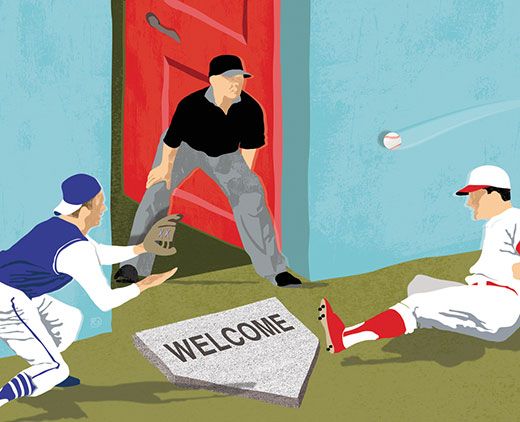This Baseball Fan Digs the Small Ball
Last year major-leaguers scored the fewest runs per game in 19 seasons. A top statistician says that’s something to root, root, root for
Baseball is about homecoming,” A. Bartlett Giamatti once wrote. “It is a journey by theft and strength, guile and speed, out around first to the far island of second, where foes lurk in the reefs and the green sea suddenly grows deeper, then to turn sharply, skimming the shallows, making for a shore that will show a friendly face, a color, a familiar language and, at third, to proceed, no longer by paths indirect but straight, to home.”
The eloquence of the late scholar and baseball commissioner stands in delightful contrast to the description of home plate in the game’s rule book—“a five-sided slab of whitened rubber” in the form of a “17-inch square with two of the corners removed so that one edge is 17 inches long, two adjacent sides are 8 1/2 inches and the remaining two sides are 12 inches and set at [a right] angle to make a point.” But whether your interest in baseball be poetic or prosaic, home plate is indisputably the alpha and omega of the game—where every batter’s hopeful journey starts, and where, should things go well, his trip becomes a certified success.
Few aspects of American life have been documented for as long and as precisely as Major League Baseball, which began playing games in 1876. And so we know that more than 17,000 major-league players have combined to make more than 15 million trips to home plate. And the trip around the bases has been completed more than 1.8 million times (over 260,000 times by means of a home run).
You can read the history of the game in the scoring fluctuations from era to era. In most 19th-century seasons, the average number of runs scored per game (by both teams) exceeded ten. It declined in the dead-ball era of the early 20th century, to 6.77 in 1908—the all-time low. It rose through the 1920s—Babe Ruth’s prime—and hit 11.10 in 1930, the all-time high. It hovered roughly between eight and nine in the 1940s and ’50s, but sank in the ’60s as pitchers dominated.
In 1969 the pitcher’s mound was lowered and four teams were added, and in 1973 the American League introduced the designated hitter rule; the scoring average rose above eight runs per game again. After players discovered performance-enhancing substances, it surpassed 10 three times in the five seasons between 1996 and 2000. Now baseball has drug-testing agreements and a new generation of outstanding pitchers; teams averaged 8.57 runs per game in 2011.
That was the lowest in 19 years. But it’s also close to the midpoint between the all-time high and low. The reduction in extrinsic influences has led to a rebalancing, a restoration, a return to more familiar ground—a homecoming for the game itself.
